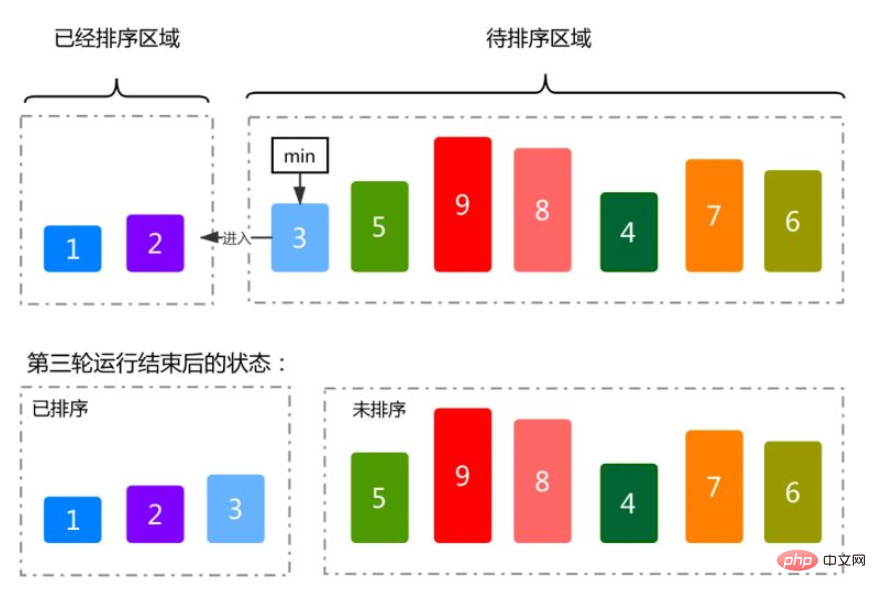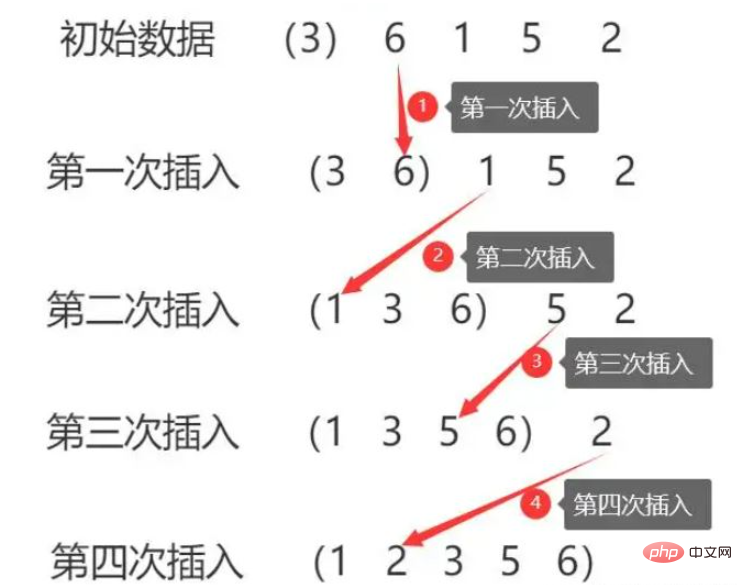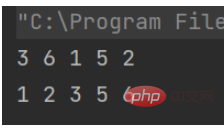 Java
Java
 javaTutorial
javaTutorial
 Detailed explanation of commonly used sorting algorithms and implementation methods in Java
Detailed explanation of commonly used sorting algorithms and implementation methods in Java
Detailed explanation of commonly used sorting algorithms and implementation methods in Java
1. Selection sort
Selection sort is a simple and intuitive sorting algorithm. No matter what data is entered, the time complexity is O(n²). So when using it, the smaller the data size, the better. The only advantage may be that it does not occupy additional memory space.

First find the smallest (large) element in the unsorted sequence and store it at the starting position of the sorted sequence.
Continue to find the smallest (large) element from the remaining unsorted elements, and then put it at the end of the sorted sequence.
Repeat the second step until all elements are sorted.
public static void selectSort(int[] arr) {
//选择排序
if(arr == null || arr.length < 2) {
return;
}
int n = arr.length;
for (int i = 0; i < n; i++) {
int minValueIndex = i;
for (int j = i+1; j < n; j++) {
minValueIndex = arr[j] < arr[minValueIndex] ? j : minValueIndex;
}
swap(arr,i,minValueIndex);
}
}
public static void swap(int[] arr,int i,int j) {
int tmp = arr[i];
arr[i] = arr[j];
arr[j] = tmp;
}
public static void printArray(int[] arr) {
for (int i = 0; i < arr.length; i++) {
System.out.print(arr[i]+" ");
}
System.out.println();
}
public static void main(String[] args) {
int[] arr = {7,5,1,9,4,2,6};
printArray(arr);
selectSort(arr);
printArray(arr);
}
2. Bubble sorting
**The principle of bubble sorting algorithm is as follows: **
1. Compare adjacent Elements. If the first one is bigger than the second one, swap them both.
2. Do the same for each pair of adjacent elements, starting with the first pair and ending with the last pair. At this point, the last element should be the largest number.
3. Repeat the above steps for all elements except the last one.
4. Continue to repeat the above steps for fewer and fewer elements each time until there are no pairs of numbers to compare.

public static void bubbleSort(int[] arr) {
if(arr == null || arr.length < 2) {
return;
}
int n = arr.length;
for (int i = n-1; i >= 0; i--) {
for (int j = 0; j < i; j++) {
if(arr[j] > arr[j+1]) {
swap(arr,j,j+1);
}
}
}
}
public static void swap(int[] arr,int i,int j) {
int tmp = arr[i];
arr[i] = arr[j];
arr[j] = tmp;
}
public static void main(String[] args) {
int[] arr = {14,6,3,10,2};
printArray(arr);
bubbleSort(arr);
printArray(arr);
}3. Insertion sort
Insertion sort means that among the elements to be sorted, assume that the first n-1 (n>=2) The numbers are already in order. Now insert the nth number into the previously arranged sequence, and then find a suitable position so that the sequence in which the nth number is inserted is also in order. The process of inserting all elements according to this method until the entire sequence is in order is called insertion sort

public static void insertSort(int[] arr) {
if(arr == null || arr.length < 2) {
return;
}
int n = arr.length;
for (int i = 1; i < n; i++) {
int currIndex = i;
while(currIndex - 1 >= 0 && arr[currIndex-1] > arr[currIndex]) {
swap(arr,currIndex,currIndex-1);
currIndex--;
}
}
}
public static void swap(int[] arr,int i,int j) {
int tmp = arr[i];
arr[i] = arr[j];
arr[j] = tmp;
}
public static void main(String[] args) {
int[] arr = {3,6,1,5,2};
printArray(arr);
insertSort(arr);
printArray(arr);
}
Insertion sort Optimization
public static void insertSort1(int[] arr) {
if(arr == null || arr.length < 2) {
return;
}
int n = arr.length;
for (int i = 1; i < n; i++) {
for (int j = i-1; j >= 0; j--) {
if(arr[j] > arr[j+1]) {
swap(arr,j,j+1);
}else {
break;
}
}
}
}
The above is the detailed content of Detailed explanation of commonly used sorting algorithms and implementation methods in Java. For more information, please follow other related articles on the PHP Chinese website!

Hot AI Tools

Undresser.AI Undress
AI-powered app for creating realistic nude photos

AI Clothes Remover
Online AI tool for removing clothes from photos.

Undress AI Tool
Undress images for free

Clothoff.io
AI clothes remover

Video Face Swap
Swap faces in any video effortlessly with our completely free AI face swap tool!

Hot Article

Hot Tools

Notepad++7.3.1
Easy-to-use and free code editor

SublimeText3 Chinese version
Chinese version, very easy to use

Zend Studio 13.0.1
Powerful PHP integrated development environment

Dreamweaver CS6
Visual web development tools

SublimeText3 Mac version
God-level code editing software (SublimeText3)

Hot Topics
 1386
1386
 52
52
 Perfect Number in Java
Aug 30, 2024 pm 04:28 PM
Perfect Number in Java
Aug 30, 2024 pm 04:28 PM
Guide to Perfect Number in Java. Here we discuss the Definition, How to check Perfect number in Java?, examples with code implementation.
 Weka in Java
Aug 30, 2024 pm 04:28 PM
Weka in Java
Aug 30, 2024 pm 04:28 PM
Guide to Weka in Java. Here we discuss the Introduction, how to use weka java, the type of platform, and advantages with examples.
 Smith Number in Java
Aug 30, 2024 pm 04:28 PM
Smith Number in Java
Aug 30, 2024 pm 04:28 PM
Guide to Smith Number in Java. Here we discuss the Definition, How to check smith number in Java? example with code implementation.
 Java Spring Interview Questions
Aug 30, 2024 pm 04:29 PM
Java Spring Interview Questions
Aug 30, 2024 pm 04:29 PM
In this article, we have kept the most asked Java Spring Interview Questions with their detailed answers. So that you can crack the interview.
 Break or return from Java 8 stream forEach?
Feb 07, 2025 pm 12:09 PM
Break or return from Java 8 stream forEach?
Feb 07, 2025 pm 12:09 PM
Java 8 introduces the Stream API, providing a powerful and expressive way to process data collections. However, a common question when using Stream is: How to break or return from a forEach operation? Traditional loops allow for early interruption or return, but Stream's forEach method does not directly support this method. This article will explain the reasons and explore alternative methods for implementing premature termination in Stream processing systems. Further reading: Java Stream API improvements Understand Stream forEach The forEach method is a terminal operation that performs one operation on each element in the Stream. Its design intention is
 TimeStamp to Date in Java
Aug 30, 2024 pm 04:28 PM
TimeStamp to Date in Java
Aug 30, 2024 pm 04:28 PM
Guide to TimeStamp to Date in Java. Here we also discuss the introduction and how to convert timestamp to date in java along with examples.
 Java Program to Find the Volume of Capsule
Feb 07, 2025 am 11:37 AM
Java Program to Find the Volume of Capsule
Feb 07, 2025 am 11:37 AM
Capsules are three-dimensional geometric figures, composed of a cylinder and a hemisphere at both ends. The volume of the capsule can be calculated by adding the volume of the cylinder and the volume of the hemisphere at both ends. This tutorial will discuss how to calculate the volume of a given capsule in Java using different methods. Capsule volume formula The formula for capsule volume is as follows: Capsule volume = Cylindrical volume Volume Two hemisphere volume in, r: The radius of the hemisphere. h: The height of the cylinder (excluding the hemisphere). Example 1 enter Radius = 5 units Height = 10 units Output Volume = 1570.8 cubic units explain Calculate volume using formula: Volume = π × r2 × h (4
 Create the Future: Java Programming for Absolute Beginners
Oct 13, 2024 pm 01:32 PM
Create the Future: Java Programming for Absolute Beginners
Oct 13, 2024 pm 01:32 PM
Java is a popular programming language that can be learned by both beginners and experienced developers. This tutorial starts with basic concepts and progresses through advanced topics. After installing the Java Development Kit, you can practice programming by creating a simple "Hello, World!" program. After you understand the code, use the command prompt to compile and run the program, and "Hello, World!" will be output on the console. Learning Java starts your programming journey, and as your mastery deepens, you can create more complex applications.



